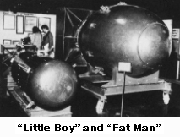History of
the HEPA Filter:
The first HEPA filter (high
efficiency particulate air) was designed in the 1940's by the
research and development firm Arthur D. Little under a classified
government contract as part of the Manh attan
Project, where the first atomic bomb was developed during World
War II. A major advancement in air filtration technology, the
filter solved a critical need to control very small particles
which had become contaminated by nuclear radioactive sources.
attan
Project, where the first atomic bomb was developed during World
War II. A major advancement in air filtration technology, the
filter solved a critical need to control very small particles
which had become contaminated by nuclear radioactive sources.
Considering the condensation
nuclei of radioactive iodine to be most harmful, researchers
focused on the ability to capture solid particles that were created
through the condensation of gases and liquid aerosols into solid
matter. Having identified 0.3 micron size particles as the most
penetrating size particle and representative of the particle
of concern, 0.3 microns was established as the particle size
fraction at which to determine filter efficiency performance.
Because of its effectiveness,
the filter was originally refered to as an "absolute filter."
The generic acronym HEPA came into use some time following 1950
when the filter was commercializ ed
and the original term became a registered tradename.
ed
and the original term became a registered tradename.
Over the next 50 years, HEPA
filtration gradually evolved as technological breakthroughs in
aerospace, pharmaceutical processing, photographic film manufacturing,
data processing and microcircuitry demanded higher and higher
levels of air cleanliness. If not for HEPA filtration, such milestones
as the lunar landing and the introduction of the silicon chip
might not have been achieved and adequate control of hazardous
and toxic particulate would not be possible.
Today, the HEPA acronym is
used primarilly in the USA whereas Europeans often refer to the
same filter as an S-Class filter. This indicates that the filter
meets standards like the British Standard 5415 and German norm:
DIN 2418B Ti-E EU 13 for filtration performance.
< Return
to the Top >